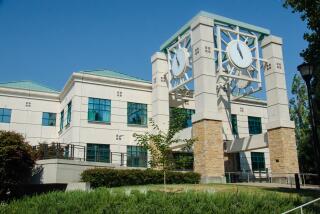State Tells Landfill Operators to End Threat of Pollution to Ground Water
Ground water at landfills in La Puente, Pomona and seven other locations throughout the Los Angeles area is threatened by liquid waste produced when methane is extracted from decomposing garbage, state water officials say.
Samples of the liquid, called gas condensate, taken from the nine landfills all contained unacceptable levels of a variety of hazardous chemicals, according to a study conducted by the state-run Los Angeles Regional Water Quality Control Board.
The study, begun after contamination of ground water was found at several landfills in 1984, was released recently by the regional board.
At a meeting two weeks ago, the board considered ordering all the landfills, including Puente Hills landfill in La Puente and Spadra landfill in Pomona, to stop the condensate disposal within 90 days.
Overestimating Problem
But several landfill operators argued that the state had overestimated the condensate problem and that more tests and more time were needed to solve the problem.
The board delayed any action until April. In the meantime, the landfill operators, including the county and city sanitation departments, have been told to devise plans to eliminate the condensate discharge.
For years, many landfills in the region--including some that no longer accept waste--have had systems in place to extract methane, which is produced when bacteria and other micro-organisms consume buried garbage.
As the waste decomposes, methane, carbon dioxide and other gases are released. If the methane is not collected, it can migrate through the ground, creating an odor and posing a risk of explosion if it collects in enclosed spaces.
Gas-extraction systems are typically a network of perforated pipes sunk into the layers of aging waste, said Steve Maguin, head of Los Angeles County’s Solid Waste Management Department, which operates the 416-acre Calabasas landfill and three others on the state’s list.
A vacuum pump pulls any gas accumulating in the waste into the pipes. It is then burned in flares or used to power electrical generators.
The condensate is created as a byproduct when the methane, water vapor and other gases--all warmed by chemical reactions that occur when the microbes devour the waste--cool as they are drawn into the pipes. Condensation forms in the pipes in a process similar to the misting of a window as hot air hits cool glass.
In most gas-extraction systems, the condensate trickles down the pipes to traps at low points in the pipe network. In most cases, it has been allowed to drain from the traps directly into the underlying soil.
Officials first realized that gas condensate could carry toxic chemicals into ground water in 1984, after extensive testing at landfills in West Covina, Azusa and Monterey Park disclosed that such pollution had taken place, said Raymond Delacourt, senior waste resource control engineer for the regional board.
The board ordered those landfills to stop discharging gas condensate and instead have it hauled to licensed toxic-waste dumps.
That is also when the board started the broad study of all landfills within its jurisdiction--encompassing most of Los Angeles and Ventura counties--that extracted gas and might have a condensate-disposal problem, Delacourt said.
About 30 Landfills Studied
The 30 or so landfills in the area that have gas-extraction systems were assessed, he said.
The landfills, besides Puente Hills and Spadra, that were tentatively identified as having unacceptable condensate-disposal systems are Sheldon-Arleta landfill in Sun Valley, Watson landfill in Wilmington, Calabasas landfill in Agoura, Mission Canyon landfill in Los Angeles, Santa Clara landfill in Oxnard and two landfills in Scholl Canyon, one operated by the county, the other by the city of Glendale.
The level of risk posed by the disposal of gas condensate at the landfills was determined by weighing several factors, including the amount of liquid discharged, the concentration of pollutants in the liquid and the proximity of each landfill to ground water used for drinking.
One of the most serious potential problems exists at the Sheldon-Arleta landfill, which lies near an important source of Los Angeles drinking water, Delacourt said.
The landfill is next to Los Angeles Department of Water and Power “spreading grounds,” where water brought to Los Angeles in aqueducts is released and enters the soil, replenishing San Fernando Valley ground water, according to the state report.
There is evidence of a leak between the DWP facility and the landfill, according to the report, which pointed out: “Therefore, disposal of any liquid at this site may have a detrimental effect on the usable water.”
Soil Composition
Another factor that put Sheldon-Arleta on the list is the porous, gravelly composition of the soil beneath the landfill, which would allow any pollutants to migrate away from the site. The landfill was built on what was formerly a gravel pit, the report said.
Tests of condensate from the city-run landfill turned up relatively low concentrations of hazardous substances, but the dump made the list because the estimated amount of condensate produced and dumped there is high--227 gallons a day, according to the regional board’s report.
Robert Alpern, principal sanitary engineer for the city Bureau of Sanitation, said new samples of gas condensate were drawn two weeks ago and are being tested by city laboratories for the presence of hazardous chemicals.
He said a plan will be worked out for eliminating any pollution that is found.
High Contaminant Levels
A sample of gas condensate from the Calabasas landfill, which accepted toxic waste until 1980, showed high levels of a number of chemicals. According to Maguin, whose department provided the test results used by the regional board in its assessment, the sample contained 70 parts per billion of benzene, 100 times the state-set maximum for that suspected carcinogen.
The sample also contained 200 parts per billion, five times the state limit, of methylene chloride, a common industrial solvent that is suspected of causing cancer.
Toluene, another common solvent, was detected in the sample at a concentration of 660 parts per billion. The state limit is 100 parts per billion.
Maguin said the state may have overestimated the hazard posed by these chemicals. He said the actual amount of condensate produced at the Calabasas landfill is about 30 gallons day, not the 125 gallons a day listed in the state report.
Moreover, the liquid drains into the ground from 24 traps in the gas-collecting system, he said, adding, “It’s distributed over a wide area” and thus is diluted and its movement slowed.
Disputed Figures
The report said Puente Hills landfill produces an estimated 2,000 gallons of condensate and the Spadra landfill produces about 85 gallons. John Gulledge, head of engineering for Los Angeles County Sanitation Department, which operates both sites, said the Puente Hills landfill accepts about four times as much refuse as Spadra.
Puente Hills’ condensate contains 60 parts per billion of benzene, 169 parts per billion of methylene chloride and 1,070 parts per billion of toluene.
The Spadra landfill produces an estimated 20 parts per billion of benzene, 1,300 parts per billion of methylene chloride and 550 parts per billion of toluene.
Maguin said that all the figures fluctuate and that none of the amounts pose an immediate threat to water supplies.
Delacourt agreed that pollutants would become diluted as they migrate into the soil, but, referring to the documented contamination of ground water in 1984, he said that the state does not want to risk having a similar situation develop at other landfills.
Alpern said any solution to the gas-condensate problem is going to be costly.
“We’d have to seal the condensate traps with concrete, then we’d have to have a licensed Class-One hauling firm take this material away,” he said, referring to commercial firms that dispose of toxic waste.
But, he added, the city plans to cooperate with the state water board when it decides how to proceed in April. “If we find there is a problem . . . we’ll take care of it,” Alpern said.
Staff writer Mary Barber contributed to this story.
More to Read
Start your day right
Sign up for Essential California for news, features and recommendations from the L.A. Times and beyond in your inbox six days a week.
You may occasionally receive promotional content from the Los Angeles Times.






